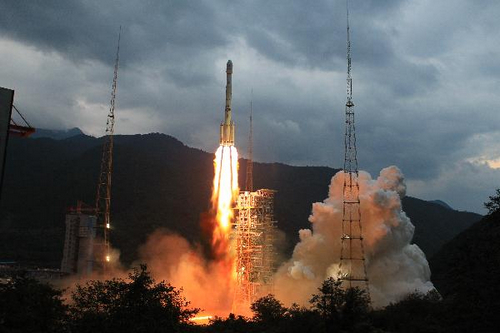Center
China successfully launches 2nd lunar probe
(Xinhua)
Updated: 2010-10-01 20:46
 |
Large Medium Small |
|
 Long March 3C rocket carrying China's second unmanned lunar probe, Chang'e-2, lifts off from the launch pad at the Xichang Satellite Launch Center in southwest China's Sichuan Province, at 18:59:57 (Beijing time)on Oct. 1, 2010. [Photo/Xinhua] |
XICHANG, Sichuan - China's lunar probe Chang'e-2 was successfully launched, control center at the Xichang satellite launch site in southwest China's Sichuan Province announced Friday.
|
||||
The control center made the announcement after the satellite successfully entered the orbit and unfolded its solar panels.
At 6:59:57 pm, the satellite blasted off on a Long March 3C carrier rocket from No 2 launch tower at the Xichang Satellite Launch Center.
The lunar satellite is expected to take about 112 hours, or almost five days, to arrive at its lunar orbit.
"Chang'e-2 lays foundation for the soft-landing on the moon and further exploration of outer space," said Wu Weiren, chief designer of China's lunar orbiter project.
It was the first time that a Chinese lunar probe directly entered the earth-moon transfer orbit without orbiting the earth first.
"It is a major breakthrough of the rocket design, as it saves energy used by the satellite and speeds up the journey to the lunar orbit," said Pang Zhihao, a researcher with the China Academy of Space Technology.
The lunar satellite is expected to take about 112 hours, or almost five days, to arrive at its lunar orbit, faster than the 12 days taken by the Chang'e-1 three years ago.
"It travels faster and closer to the moon, and it will capture clear pictures," Wu said.
Chang'e-2, named after a legendary Chinese goddess of moon, will orbit 100 kilometers above the moon, compared with 200 kilometers for Chang'e-1.
Total expenditure for the Chang'e-2 mission is about 900 million yuan ($134.33 million).
China launched its first lunar probe, Chang'e-1, in October 2007, marking a milestone in the country's space exploration.
After orbiting for 494 days and intentionally crashing onto the lunar surface, Chang'e-1 sent back 1.37 terabytes of data, producing China's first complete moon picture. The data has been shared with other countries for free.
China became the third country after Russia and the United States to send a person into space in 2003.
Two more manned space missions followed with the most recent in 2008 involving China's first human space walk.



